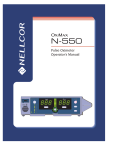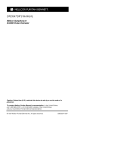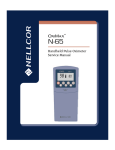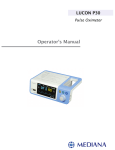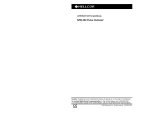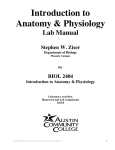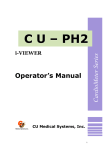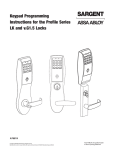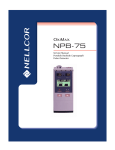Download Nellcor N40 Operator`s Manual
Transcript
OPERATOR’S MANUAL NPB-40 Handheld Pulse Oximeter Caution: Federal law (U.S.) restricts this device to sale by or on the order of a physician. To contact Mallinckrodt’s representative: In the United States, call 1-800635.5267; outside of the United States, call your local Mallinckrodt representative. 012 3 © 2001 Mallinckrodt Inc. All rights reserved. 060328B-0601 Nellcor Puritan Bennett Inc. 4280 Hacienda Drive Pleasanton, CA 94588 USA Telephone Toll Free 1.800.NELLCOR Tyco Healthcare UK LTD Fareham Road Gosport PO13 0AS U.K. Tel: 44.1329.224000 Nellcor Puritan Bennett Inc. is a wholly-owned subsidiary of Mallinckrodt Inc. Nellcor and Nellcor Puritan Bennett are trademarks of Mallinckrodt Inc. To obtain information about a warranty, if any, for this product, contact Mallinckrodt Technical Services Department, or your local Mallinckrodt representative. The following are trademarks of Mallinckrodt Inc.: Durasensor, Oxiband, Oxisensor, Oxisensor II, OxiCliq, and Dura-Y. Covered by one or more of the following U.S. Patents and foreign equivalents: 4,621,643; 4,685,464; 4,700,708; and 4,770,179. CONTENTS Figures Tables Figures ............................................................................... Tables ................................................................................ SAFETY INFORMATION ......................................................... General Safety Information ................................................ INTRODUCTION ...................................................................... Intended use ...................................................................... General Operating Principles and Conditions ................... CONTROLS, INDICATORS, AND SYMBOLS ......................... Displays, Controls, Indicators, and Connectors ................ Other NPB-40 Symbols ...................................................... Description of Controls ...................................................... Function Keys .............................................................. Status Icons ................................................................. Description of Visual Indicators and Displays .................... Description of Audible Indicators ....................................... SETUP ...................................................................................... Unpacking and Inspection.................................................. Testing ............................................................................... List of Components ............................................................ Optional Accessories ................................................... Monitor Setup ..................................................................... Installing the Batteries.................................................. General ........................................................................ NELLCOR SENSORS .............................................................. Selecting a Sensor ............................................................. Biocompatibility Testing ............................................... Performance Considerations ............................................. START-UP AND USE............................................................... Basic Operation ................................................................. Power-On Self-Test (POST) ........................................ Monitoring Mode .......................................................... Pulse Search Mode ..................................................... Determining Software Version ........................................... Silencing or Adjusting Pulse Beep Volume ....................... Turning Display Light (Backlight) On or Off ....................... Storing Event Data ............................................................. Printing Event Data ............................................................ iii iii 1 1 3 3 3 5 5 7 8 8 8 9 10 11 11 11 11 11 12 12 13 15 15 16 16 19 19 20 21 22 23 23 23 23 24 iii Contents Preparing the NPB-40 for Printing ............................... Single Event Report ..................................................... Multiple Event Report .................................................. Printer and Printer Accessories ................................... Sensor Disconnect Indicator .............................................. Battery Operation............................................................... Disposal of Device Components ....................................... Performance Considerations.............................................. Impact of Patient Conditions on Monitor Readings...... TROUBLESHOOTING AND MAINTENANCE ......................... Troubleshooting ................................................................. EMI Interference ................................................................ Obtaining Technical Assistance ......................................... Returning the NPB-40 ....................................................... Maintenance ...................................................................... Service ......................................................................... Cleaning....................................................................... Periodic Safety Checks ...................................................... SPECIFICATIONS ................................................................... Performance ...................................................................... Electrical ............................................................................ Environmental .................................................................... Physical.............................................................................. APPENDIX: PRINCIPLES OF OPERATION ............................ Oximetry Overview............................................................. Automatic Calibration................................................... Functional Versus Fractional Saturation...................... Measured Versus Calculated Saturation..................... 24 26 27 28 28 28 29 30 30 31 31 33 34 34 35 35 35 35 37 37 38 38 39 41 41 42 42 43 FIGURES Figure 1: NPB-40 Front/Side View ........................................... Figure 2: NPB-40 Front Panel Display...................................... Figure 3: NPB-40 Rear View .................................................... Figure 4: NPB-40 Top View ...................................................... Figure 5: Installing Batteries ..................................................... Figure 6: Aligning the NPB-40 and Printer ................................ Figure 7: Single Event Report................................................... Figure 8: Multiple Event Report ................................................ Figure 9: Oxyhemoglobin Dissociation Curve........................... 5 6 6 7 12 25 26 27 43 TABLES Table 1: Nellcor Sensors........................................................... 15 iv SAFETY INFORMATION General Safety Information GENERAL SAFETY INFORMATION This section contains important safety information related to general use of the NPB-40 monitor. Other important safety information appears throughout the manual in sections that relate specifically to the precautionary information. Be sure to read all text surrounding all precautionary information. Important! Before use, carefully read this manual, accessory directions for use, all precautionary information in boldface type, and specifications. WARNING: The NPB-40 is a prescription device and is to be operated by qualified personnel only. WARNING: The NPB-40 is not equipped with alarms. The monitor is for attended monitoring only, and must be used under the direct supervision of a qualified health care provider. WARNING: Explosion hazard. Do not use the NPB-40 pulse oximeter in the presence of flammable anesthetics. WARNING: The cover should be removed only by qualified service personnel. There are no userserviceable parts inside. WARNING: To ensure accurate performance and prevent device failure, do not expose the NPB-40 to extreme moisture, such as rain. Caution: The NPB-40 is intended only as an adjunct in patient assessment. It must be used in conjunction with clinical signs and symptoms. WARNING: Pulse oximetry readings and pulse signal can be affected by certain ambient environmental conditions, sensor application errors, and certain patient conditions. 1 Safety Information To ensure accurate readings, consider the environmental conditions that are present and the condition of the patient. See the appropriate sections of the manual for specific safety information related to these conditions. WARNING: If you are uncertain about the accuracy of any measurement, check the patient’s vital signs by alternate means, then make sure the monitor is functioning correctly. 2 INTRODUCTION Intended Use General Operating Principles and Conditions INTENDED USE The Nellcor NPB-40 handheld pulse oximeter is intended for noninvasive spot-check measurement of functional oxygen saturation of arterial hemoglobin (SpO2 ), and pulse rate (measured by SpO 2 sensor). The monitor is intended for use on adult, pediatric, and neonatal patients. It can be used in mobile environments when protected from excessive moisture such as direct rainfall. Caution: The NPB-40 is intended only as an adjunct in patient assessment. It must be used in conjunction with clinical signs and symptoms. WARNING: The NPB-40 is not equipped with alarms. The monitor is for attended monitoring only, and must be used under the direct supervision of a qualified health care provider. WARNING: Do not use the NPB-40 or Nellcor sensors during magnetic resonance imaging (MRI) scanning. Induced current could potentially cause burns. The NPB-40 may affect the MRI image; the MRI unit may affect the accuracy of oximetry measurements. Caution: The NPB-40 may be used during defibrillation, but the readings may be inaccurate for a short time. The battery-operated NPB-40 is designed to send previously stored patient data to an external Hewlett-Packard HP82240B printer, available from Mallinckrodt. GENERAL OPERATING PRINCIPLES AND CONDITIONS The NPB-40 uses pulse oximetry to measure oxygen saturation in the blood. Pulse oximetry works by applying a sensor to pulsating arteriolar vascular bed, such as a finger or toe. The sensor contains a dual light source and a photodetector. 3 Introduction Bone, tissue, pigmentation, and venous vessels normally absorb a constant amount of light over time. The arteriolar bed normally pulsates and absorbs variable amounts of light during the pulsations. The ratio of light absorbed is translated in an oxygen saturation measurement (SpO 2). Because a measurement of SpO2 is dependent on light from the sensor, excessive ambient light can interfere with this measurement. WARNING: Pulse oximetry readings and pulse signal can be affected by certain ambient environmental conditions, sensor application errors, and certain patient conditions. Specific information about ambient environmental conditions, sensor application, and patient conditions, is contained throughout this manual. 4 CONTROLS, INDICATORS, AND SYMBOLS Displays, Controls, Indicators, and Connectors Other NPB-40 Symbols Description of Controls Description of Visible Indicators and Displays Description of Audible Indicators DISPLAYS, CONTROLS, INDICATORS, AND CONNECTORS Figures 1 through 4 show the front, side, rear, and top views of the NPB-40 and identify displays, controls, and connectors. 1 2 3 4 1. Function keys 2. Status icons 3. Digital display 4. Sensor port Figure 1: NPB-40 Front/Side View 5 Controls, Indicators, and Symbols 1 15 2 14 13 12 3 4 11 6 5 10 1. 2. 3. 4. 5. 6. 7. 8. 9 8 7 Pulse Amplitude indicator Pulse Rate display Pulse Search indicator Low Battery indicator Sensor Disconnect indicator Power On/Off key (Shift+) Beep On/Off key Display Light key 9. 10. 11. 12. 13. 14. 15. (Shift+) Print key Store Data key Shift Key Store Data icon Shift Key icon Print icon SpO2% display Figure 2: NPB-40 Front Panel Display 2 1 3 1. Sound ports 2. Battery compartment latch 3. Battery compartment door Figure 3: NPB-40 Rear View 6 Controls, Indicators, and Symbols 1. Printer infrared window 1 Figure 4: NPB-40 Top View OTHER NPB-40 SYMBOLS Attention: See Instructions for Use Percent oxygen saturation /min Pulse rate, measured in beats per minute (bpm) Type BF equipment Alkaline “AA” size, 1.5 V batteries 7 Controls, Indicators, and Symbols DESCRIPTION OF CONTROLS Function Keys Power On/Off key. This key is used to turn the NPB-40 monitor on or off. Shift key. When pressed in conjunction with another Function key, the Shift key changes the function of the other key to that designated by its upper icon. Combo 1 key. When pressed by itself, this key functions as the Store Data key (lower icon). It stores the currently displayed patient data for printing at a later time. Pressing the Shift key before pressing the Combo1 key, changes the function to that of a Print key (upper icon). This action sends patient data to an active, properly aligned, HewlettPackard printer, to generate a printed report. Combo 2 key. When pressed by itself, this key functions as the Display Light key (lower icon). It turns the display backlight on or off. Pressing the Shift key before pressing the Combo 2 key, changes the function that of a Beep On/Off key (upper icon). This action silences or adjusts the pulse beep volume (see “Silencing or Adjusting Beep Volume” in the Start-Up and Use section of this manual). Status Icons Shift icon lights when the Shift key function is in use. Store Data icon lights when the Store Data function is in use. While the icon is lit, either during data storage or printing, the event number is shown on the display. 8 Controls, Indicators, and Symbols Print icon lights when the Print function is in use. Note: while printing, the monitor does not measure SpO2 . The Pulse Search icon lights prior to initial acquisition of a pulse signal, and during Pulse Search mode. The Low Battery icon flashes when 45 minutes or less battery capacity remains (with disposable batteries). The icon flashes at least once per second. Refer to “Battery Operation” in the StartUp and Use section for a discussion regarding use of disposable and rechargeable batteries. The Sensor Disconnect icon lights when the NPB-40 does not detect the connection of an SpO 2 sensor to the monitor. DESCRIPTION OF VISUAL INDICATORS AND DISPLAYS The SpO2 % display show hemoglobin oxygen saturation level. It is updated with each pulse. Synchronous with each pulse, the monitor beeps. If the SpO 2 level drops by more than 2%, the monitor will emit a double-beep tone. The Pulse Amplitude indicator is a 10-segment display that shows the relative pulse amplitude. As the detected pulse becomes stronger, more contiguous segments light with each pulse. The digital Pulse Rate display shows the pulse rate in beats per minute. It is updated with each pulse. 9 Controls, Indicators, and Symbols DESCRIPTION OF AUDIBLE INDICATORS Following are audible indicators for which there are no accompanying symbols, keys, or visual indicators. WARNING: The NPB-40 is not equipped with alarms. The monitor is for attended monitoring only, and must be used under the direct observation of a qualified health care provider. 10 Power-Up Self-Test pass One 2-second tone No sensor connected at startup (or sensor disconnected) Error tone (dual-pitch tone) for 3 seconds SpO 2 drop of more than 2% 1 double-beep tone No Pulse detected for 30 seconds after power-up 2 triple-beeps, then NPB-40 turns itself off Pulse acquired, then lost. No pulse detected for 15 minutes, and event memory is empty. 2 triple-beeps, then NPB-40 turns itself off Pulse acquired, then lost. No pulse detected for 60 minutes, and event memory is not empty. 1 triple-beep every 10 seconds Low Battery 1 triple-beep tone at 3-minute intervals Impending Dead Battery 2 triple-beep tones, then NPB-40 turns itself off SETUP Unpacking and Inspection Testing List of Components Monitor Setup UNPACKING AND INSPECTION Notify the carrier if the shipping carton is damaged. Unpack the NPB-40 and components. If anything is missing or damaged, contact Mallinckrodt Technical Services Department or your local Mallinckrodt representative. TESTING Before using the NPB-40 in a clinical setting, verify that the monitor functions properly by following the instructions in the Start-Up and Use section of this manual. LIST OF COMPONENTS 1 4 1 1 1 Nellcor NPB-40 handheld pulse oximeter Alkaline “AA” size, 1.5 V batteries Durasensor ® oxygen transducer, model DS-100A Operator’s manual Quick Guide adhesive label Optional Accessories The following items are available from Mallinckrodt for use with this monitor: • • • • • Protective “Boot” Rain Jacket Carrying Case Hewlett-Packard printer, model HP82240B Hewlett-Packard printer paper 11 Setup MONITOR SETUP Installing the Batteries 1. Pull the battery compartment latch downward, toward the bottom of the monitor, and remove the battery access door. 2. Install four “AA” size batteries, oriented as shown in Figure 5. Replace the battery access door. Note: Install the negative end of each battery first, compressing the battery terminal spring until the positive terminal clears the positive spring, and pressing the battery downward, into place. To remove the batteries, reverse the installation process, removing the positive end of each battery first. Refer to “Battery Operation” in the Start-Up and Use section of this manual for important information including the types of batteries to be used with the NPB-40, and precautionary information. Figure 5: Installing Batteries 12 Setup General WARNING: Explosion hazard. Do not use the NPB-40 handheld pulse oximeter in the presence of flammable anesthetics. WARNING: To ensure patient safety, do not place the monitor in any position that might cause it to fall on the patient. WARNING: As with all medical equipment, carefully route patient cabling to reduce the possibility of patient entanglement or strangulation. WARNING: To ensure accurate performance and prevent device failure, do not expose the NPB-40 to extreme moisture such as rain. 13 (This page intentionally left blank) NELLCOR SENSORS Selecting a Sensor Performance Considerations SELECTING A SENSOR WARNING: Before use, carefully read the sensor directions for use, including all warnings, cautions, and instructions. WARNING: Do not use a damaged sensor. Do not use a sensor with exposed optical components. WARNING; Use only Nellcor sensors for SpO2 measurements. Other sensors may cause improper NPB40 performance. When selecting a sensor, consider the patient’s weight and activity level, the adequacy of perfusion, the available sensor sites, the need for sterility, and the anticipated duration of monitoring. For more information, refer to Table 1 or contact your local Mallinckrodt representative. Table 1: Nellcor Sensors Sensor Model Patient Size Oxisensor® and Oxisensor II oxygen transducers (Sterile, single-use only) N-25 I-20 D-20 D-25(L) R-15 <3 or >40 kg 3–20 kg 10–50 kg >30 kg >50 kg Oxiband® oxygen transducers (Reusable with disposable nonsterile adhesive) OXI-A/N OXI-P/I <3 or >40 kg 3–40 kg Durasensor® oxygen transducer (Reusable, nonsterile) DS-100A >40 kg Nellcor reflectance oxygen transducer (Reusable, nonsterile) RS-10 >40 kg Dura-Y ® m u l t i s i t e oxygen transducer (Reusable, nonsterile) D-YS >1 kg OxiCliq® oxygen transducers (Sterile, single-use only) P N I A 10 to 50 kg <3 or >40 kg 3 to 20 kg >30 kg 15 Nellcor Puritan Bennett Sensors Biocompatibility Testing Biocompatibility testing has been conducted on Nellcor sensors in compliance with ISO 10993-1, Biological Evaluation of Medical Devices, Part 1: Evaluation and Testing. The sensors have passed the recommended biocompatibility testing and are, therefore, in compliance with ISO 10993-1. PERFORMANCE CONSIDERATIONS WARNING: Pulse oximetry readings and pulse signal can be affected by certain ambient environmental conditions, sensor application errors, and certain patient conditions. Inaccurate measurements can be caused by: • incorrect application of the sensor • placement of the sensor on an extremity with a blood pressure cuff, arterial catheter, or intravascular line • ambient light • patient movement Loss of pulse signal can occur for the following reasons: • the sensor is too tight • a blood pressure cuff is inflated on the same extremity as the one with the sensor attached • there is arterial occlusion proximal to the sensor Use only Nellcor sensors and sensor cables. Select an appropriate sensor, apply it as directed, and observe all warnings and cautions presented in the directions for use accompanying the sensor. Clean and remove any substances such as nail polish from the application site. Periodically check to see that the sensor remains properly positioned on the patient. 16 Nellcor Puritan Bennett Sensors WARNING: Tissue damage can be caused by incorrect application or duration of use of an SpO 2 sensor. Inspect the sensor site as directed in the sensor directions for use. High ambient light sources such as surgical lights (especially those with a xenon light source), bilirubin lamps, fluorescent lights, infrared heating lamps, and direct sunlight can interfere with the performance of an SpO 2 sensor. To prevent interference from ambient light, ensure the sensor is properly applied, and cover the sensor site with opaque material. Note: Failure to take this precaution in high ambient light conditions may result in inaccurate measurements. If patient movement presents a problem, try one or more of the following remedies to correct the problem. • • • • Verify that the sensor is properly and securely applied. Move the sensor to a less active site. Use an adhesive sensor that tolerates some patient motion. Use a new sensor with fresh adhesive backing. If poor perfusion affects performance, consider using the Oxisensor R-15 sensor; it obtains measurements from the nasal septal anterior ethmoid artery, an artery supplied by the internal carotid. This sensor may obtain measurements when peripheral perfusion is relatively poor. For low peripheral perfusion, consider using the Nellcor RS-10 sensor, which is applied to the forehead or temple, sites that may be spared during peripheral vasoconstriction. Note: The preceding section pertains to patient and environmental conditions that can be addressed by sensor selection and application. For information regarding the impact of other patient and environmental conditions on oximeter performance, see “Performance Considerations” in the Start-Up and Use section. 17 (This page intentionally left blank) START-UP AND USE Basic Operation Determining Software Version Silencing or Adjusting Pulse Beep Volume Turning Display Light (Backlight) On or Off Storing Event Data Printing Event Data Sensor Disconnect Indicator Battery Operation Disposal of Device Components Performance Considerations BASIC OPERATION WARNING: The NPB-40 is a prescription device and is to be operated by qualified personnel only. WARNING: Do not lift the monitor by the sensor cable because the cable could disconnect from the monitor, causing the monitor to drop on the patient. Caution: The NPB-40 is intended only as an adjunct in patient assessment. It must be used in conjunction with clinical signs and symptoms. Important! Prior to using the NPB-40, carefully read this manual, accessory directions for use, all precautionary information in boldface type, and all specifications. Before you use the NPB-40, you must verify that the monitor is working properly and is safe to use. Proper working condition can be verified by successful completion of the power-on selftest described in the following steps, and by following the instructions contained in “Monitoring Mode” in this section. Note: Before using the NPB-40, remove the plastic protective sheet that covers the display. This sheet is only on the display to protect it during shipping. Leaving it on during monitoring could make it difficult to read displayed measurements. 19 Start-Up and Use Power-On Self-Test (POST) Caution: Do not connect anything other than an SpO 2 sensor to the sensor port (for example, do not attempt to connect a PC to the NPB-40). Note: 1. It is recommended that a sensor be connected prior to start-up. If no sensor is connected at start-up, an error tone sounds for approximately 3 seconds. Plug an appropriate Nellcor sensor firmly into the sensor port, and apply the sensor to the patient as described in the sensor directions for use. If needed, use a Nellcor sensor extension cable, model EC-4 or EC-8. Caution: During the self-test (immediately after powerup), confirm that all display segments and icons light. 2. Turn on the NPB-40 by pressing the On/Off key. The monitor automatically conducts a power-on self-test, which tests its circuitry and lights the entire numeric display. 3. While performing the power-on self-test (POST), the POST Display appears for approximately 3-5 seconds. During this time: • • • • All icons light All segments of all numeric digits light All segments of the Pulse Amplitude Display light Display backlight is turned on. During POST, check to ensure that all display icons and numeric segments light. If any icon or numeric segment does not light, do not use the monitor. Instead, contact Mallinckrodt Technical Services Department, or your local Mallinckrodt representative. 4. 20 If the NPB-40 detects an internal problem during POST, an error tone sounds and the monitor displays an Error Code and corresponding number (see Troubleshooting section for error codes and necessary action that should be taken). Start-Up and Use 5. Upon successful completion of the POST, the NPB-40 sounds a 2-second tone indicating that the monitor has passed the test. 6. Once the power-on self-test is complete, and the monitor has displayed its software version (refer to discussion “Determining Software Version” in this section), the NPB-40 attempts to detect a valid pulse. If a valid pulse is not detected within 30 seconds of turning on the monitor, the NPB-40 sounds two triple beeps and then automatically shuts off to conserve battery life. If a valid pulse is detected, the NPB-40 enters Monitoring Mode. Monitoring Mode In Monitoring Mode, the NPB-40 is either taking an SpO2 measurement, storing event data, or printing data that has been stored in its memory. While taking an SpO2 measurement, the monitor displays SpO 2 and pulse rate readings with each pulse beat. The constant-pitch beep sounds once for each pulse, and the Pulse Amplitude indicator visually displays pulse strength at the sensor site. Note: Verify that indicators, icons, display information, and audible sounds are all operational, indicating that the monitor is functioning. Each valid keypress should generate an appropriate action. If any actions do not seem appropriate, do not use the monitor. Instead, contact Mallinckrodt Technical Services Department or your local Mallinckrodt representative. In Monitoring Mode, if the acquired pulse is lost, the monitor enters Pulse Search Mode. 21 Start-Up and Use Pulse Search Mode During Pulse Search Mode, the monitor attempts to detect a pulse from which to take a measurement. Note: Pulse Search is a normal function of the monitor, and entering this mode is not necessarily indicative of a lost patient pulse. At Initial Power-Up Immediately after the monitor is turned on and the power-on self-test is completed and the NPB-40 displays its software version number, the monitor enters Pulse Search Mode and the Pulse Search icon lights. The display reads zeroes while it searches for a valid pulse. If a valid pulse is detected within 30 seconds of entering this mode at initial start-up, the NPB-40 enters Monitoring Mode. If a valid pulse is not detected within 30 seconds of entering Pulse Search Mode after start-up, the monitor sounds two triple beeps, and then automatically shuts off. After Taking Measurements If a pulse was acquired previously and then lost, the NPB-40 enters Pulse Search Mode, and the Pulse Search icon lights. The display shows the last detected readings while it searches for a valid pulse. When it considers the pulse “lost,” it displays zeroes and continues its search. If a valid pulse is again detected within 15 minutes of entering Pulse Search, the NPB-40 immediately reenters Monitoring Mode. If a valid pulse is not detected within 15 minutes of entering Pulse Search Mode, the NPB-40 sounds two triple beeps and turns itself off, provided no event data has been stored since the monitor was turned on. If patient event data is stored, the monitor will remain on and, after 60 minutes, will triple-beep at 10-second intervals as a reminder. Once a valid pulse is again acquired in this mode, the instrument enters Monitoring Mode. 22 Start-Up and Use DETERMINING SOFTWARE VERSION Immediately following the successful completion of the poweron self-test, the monitor displays the software version contained in the monitor. Note: This software version number is often needed when calling Mallinckrodt Technical Services Department or your local Mallinckrodt representative for technical assistance. After displaying the software version for approximately 3-5 seconds, the Pulse Search icon lights, indicating that the NPB-40 is in operation. SILENCING OR ADJUSTING PULSE BEEP VOLUME At start-up, the pulse beep is ON, with the volume set at HIGH. By pressing the Shift key and then the Display Light/Sound (Combo 2) function key, you may cycle the NPB-40 pulse beep tone from HIGH volume through OFF, LOW volume, and then back to HIGH volume. While using the NPB-40, do not cover the holes located in the rear of the monitor. These allow the audible alert sounds (error tones) and pulse beep tones to exit the monitor. TURNING DISPLAY LIGHT (BACKLIGHT) ON OR OFF The NPB-40 has a display backlight that may be turned on and off manually. To do this, press the Display Light/Sound (Combo 2) function key by itself (do not press the Shift key). When the display backlight is on, it remains on for approximately 10 minutes, then automatically shuts off to conserve battery use. STORING EVENT DATA The NPB-40 pulse oximeter contains an internal memory that can store 50 patient data records for later printing. To activate the Store Data function: 1. While in Monitoring Mode, press the Store Data key. The monitor displays the Store Data icon along with a number that identifies the entry. It then copies the current SpO2 and pulse rate into that memory location. The Data Storage Display (indicating the ID number of the entry) remains on the screen for approximately 3 seconds from the time the Store Data key was pressed. 23 Start-Up and Use 2. When the patient data storage is completed, the monitor returns to the mode it was in previously. Note: When the Store Data key is pressed and there is NO empty event memory location available, the monitor displays the last ID number assigned (50), displays the flashing Store Data icon, and sounds an error tone for 3 seconds. Events are retained in the NPB-40 memory while the monitor remains on and are cleared when the monitor is turned off or powers itself off. If they are cleared, the events will not be available for later printing. Note: The instrument will clear all stored data if the batteries are removed. PRINTING EVENT DATA The NPB-40 has the ability to print event data when used with a Hewlett-Packard printer, model HP82240B, which is available from Mallinckrodt. Note: Read the entire user’s manual for the Hewlett-Packard HP82240B printer prior to using the printer with the NPB-40. Preparing the NPB-40 for Printing In order to print event data, the monitor and printer must be turned on, and the monitor and printer must be aligned as follows. 1. 24 Place the printer and monitor on a flat, stable surface, oriented as shown in Figure 6. Start-Up and Use 0°– 5° 0°– 5° 1"– 2" (2.5 – 5.1 cm.) Figure 6: Aligning the NPB-40 and Printer 2. The “windows” on the two instruments must be directly aligned, as shown. Note: While the NPB-40 is printing, it is not available for patient monitoring. After the monitor and printer are ON and aligned properly, data that has been stored in the monitor’s memory may be printed. To do this, press the Shift key, then press the Store Data/Print (Combo 1) key. Note: Do not move the printer or monitor during printing. This can result in an incomplete printed report. Should you move either device during the printing process enough to disrupt printing, allow the print cycle to be completed. You may then reposition the monitor and printer and begin the printing process again, as long as the monitor has remained ON. Event data reports may be printed in one of two formats: a Single Event Report, or a Multiple Event Report. 25 Start-Up and Use Single Event Report To initiate a single event report, the sensor must be on the patients finger and the NPB-40 must be displaying readings. When there are no monitoring events stored in memory, pressing the Shift + Print key will result in the monitor generating the Print Display and sending a Single Event Report to the printer. This report contains the current oxygen saturation and pulse rate information. The format for the Single Event Report follows: • • • • Name of the monitor (NPB-40) Notes Line (approximately 1/2 inch of space for handwritten notes) Elapsed time “SpO 2” and “BPM” (pulse rate) readings including minimum, maximum, and average values. See Figure 7 for a sample Single Event Report. Figure 7: Single Event Report 26 Start-Up and Use Multiple Event Report When the Shift + Print keys are pressed and there are one or more monitoring events stored in memory, the monitor generates the Printing Display and sends a Multiple Event Report to the printer, starting with the first event that was stored in memory. Note: This mode will not print out the current SpO2 and pulse rate, only the stored events. The Multiple Event Report contains the following components for each monitoring event: • • • • • Name of the monitor (NPB-40) Notes Line (approximately 1/2 inch of space for handwritten notes) Event ID (storage record number) “SpO 2” and the stored SpO 2 value on a single line “BPM” (pulse rate) and the stored Pulse Rate value on a single line See Figure 8 for a sample Multiple Event Report. Figure 8: Multiple Event Report 27 Start-Up and Use Printer and Printer Accessories The Hewlett-Packard printer model HP82240B, the printer AC adapter, and thermal printer paper refills are available from Mallinckrodt. SENSOR DISCONNECT INDICATOR When the NPB-40 is in Monitoring or Pulse Search Modes and it detects an invalid sensor connection, the Sensor Disconnect indicator flashes and the monitor generates an error tone for 3 seconds. If a valid sensor connection is not made within 30 seconds, the monitor sounds two triple-beeps, and then turns itself off. If a valid sensor connection is made within 30 seconds, the monitor begins a new Pulse Search. Note: In Monitoring Mode, if the acquired pulse is lost, the monitor enters Pulse Search Mode. Important! This transition does not generate an audible alert upon loss of pulse. BATTERY OPERATION Caution: Check the batteries periodically for corrosion. Replace batteries if corrosion is present, otherwise damage to the monitor may occur. Caution: Do not use lithium batteries with the NPB-40. Lithium batteries will damage the monitor. The NPB-40 pulse oximeter is powered by four alkaline “AA” cell batteries. Typically, a fresh set of disposable “AA” batteries will provide 19 hours of continuous monitoring (with the display backlight OFF). 28 Note: Not all brands of off-the-shelf alkaline batteries provide the same battery life. Note: Do not mix alkaline “AA” batteries with rechargeable batteries. When replacing batteries, replace with four fresh (new) batteries. Do not mix used and new batteries. Start-Up and Use Note: If the batteries are low when the monitor is turned on, the Low Battery indicator will not flash until the instrument enters normal operation. When 45 minutes or less of disposable, alkaline battery life remains, the Low Battery indicator lights and a triple-beep tone occurs at 3-minute intervals. Rechargeable alkaline batteries may be used with the NPB-40. It must be noted, however, the battery life per charge will be less than that typical for disposable batteries. In addition, each subsequent charge of the rechargeables will yield shorter battery life cycles. For example, a typical set of rechargeable alkaline batteries will usually yield 10 hours of continuous monitoring of the NPB-40, but each recharge will provide a shorter monitoring time, until the average battery life cycle is about 3.5 hours per charge. Note: Because of this decrease per charge cycle, the Low Battery Indicator and battery life specification quoted for disposable alkalines will not apply to rechargeables. Regardless of what battery type is used, when the remaining battery life is insufficient to operate the monitor within its specifications, the NPB-40 sounds two triple-beeps and turns itself off. Caution: Remove the batteries from the NPB-40 prior to storing the monitor for an extended period of time. DISPOSAL OF DEVICE COMPONENTS Caution: Follow local governing ordinances and recycling instructions regarding disposal or recycling of device components, including batteries. 29 Start-Up and Use PERFORMANCE CONSIDERATIONS Impact of Patient Conditions on Monitor Readings Certain patient conditions can affect the measurements of the NPB-40 and cause the loss of the pulse signal. WARNING: Pulse oximetry readings and pulse signals can be affected by certain ambient environmental conditions, sensor application errors, and certain patient conditions. Inaccurate measurements can be caused by: • • • • • excessive patient movement venous pulsations intravascular dyes, such as indocyanine green or methylene blue significant levels of dysfunctional hemoglobins defibrillation Ambient environmental conditions and sensor application errors, which can affect pulse oximetry readings, are discussed in the Nellcor Sensors section of this manual and in the sensor directions for use. The effects of electromagnetic interference on oximetry readings is discussed in the Troubleshooting and Maintenance section of this manual. 30 TROUBLESHOOTING AND MAINTENANCE Troubleshooting EMI Interference Obtaining Technical Assistance Returning the NPB-40 Maintenance Periodic Safety Checks TROUBLESHOOTING WARNING: If you are uncertain about the accuracy of any measurement, check the patient’s vital signs by alternate means; then make sure the monitor is functioning correctly. WARNING: The cover should be removed only by qualified service personnel. There are no user-serviceable parts inside. If you experience a problem while using the NPB-40 and are unable to correct it, contact qualified service personnel or Mallinckrodt’s representative. The NPB-40 service manual, which is for use by qualified service personnel, provides additional troubleshooting information. Following is a list of possible errors and suggestions for correcting them. 1. There is no response to the Power On/Off key. • 2. The batteries may be missing, discharged, or oriented incorrectly. One or more display segments or indicators do not light during the power-on self-test. • Do not use the NPB-40; contact qualified service personnel or your local Mallinckrodt representative. 31 Troubleshooting and Maintenance 3. 4. 32 The Pulse Search indicator is lit for more than 10 seconds. • Check the sensor directions for use to determine if an appropriate sensor is being used and if it is applied properly. Check sensor and extension cable connections. Test the sensor on someone else. Try another sensor or extension cable. • Perfusion may be too low for the NPB-40 to track the pulse. Check the patient. Test the instrument on someone else. Change the sensor site. Try another type of sensor. • Excessive patient motion may be preventing the NPB-40 from tracking the pulse. Keep the patient still, if possible. Verify that the sensor is securely applied, and replace it if necessary. Change the sensor site. Use a type of sensor that tolerates more patient movement (for example, an adhesive sensor). • The sensor may be too tight, there may be excessive ambient light, or the sensor may be on an extremity with a blood pressure cuff, arterial catheter, or intravascular line. Reposition sensor, as necessary. • Excessive environmental motion or electromagnetic interference may be preventing the NPB-40 from tracking the pulse. Remove the source of interference or try to stabilize the environment, or do both. The Pulse Search indicator lights after successful measurements have been made. • Check the patient. • Perfusion may be too low for the NPB-40 to track the pulse. Test the instrument on someone else. Change the sensor site. Try another type of sensor. • Excessive patient motion may be preventing the NPB-40 from tracking the pulse. Verify that the sensor is securely applied and replace it if necessary. Change the sensor site. Use a type of sensor that tolerates more patient movement (for example, an adhesive sensor). Troubleshooting and Maintenance 5. • The sensor may be too tight, there may be excessive ambient light, or the sensor may be on an extremity with a blood pressure cuff, arterial catheter, or intravascular line. Reposition sensor, as necessary. • Excessive environmental motion or electromagnetic interference may be preventing the NPB-40 from tracking the pulse. Remove the source of interference or try to stabilize the environment, or do both. A number followed by EEE appears on the display. • Record the number and provide that information to qualified service personnel or your local Mallinckrodt representative. EMI INTERFERENCE Caution: This device has been tested and found to comply with the limits for medical devices to the IEC 601-1-2:1993, EN60601-1-2;1994, Medical Device Directive 93/42/EEC. These limits are designed to provide reasonable protection against harmful interference in a typical medical installation. However, because of the proliferation of radio-frequency transmitting equipment and other sources of electrical noise in the health-care and home environments (for example, cellular phones, mobile two-way radios, electrical appliances), it is possible that high levels of such interference due to close proximity or strength of a source, may result in disruption of performance of this device. The NPB-40 is designed for use in environments in which the pulse can be obscured by electromagnetic interference. During such interference, measurements may seem inappropriate or the monitor may not seem to operate correctly. The NPB-40 generates, uses, and can radiate radio frequency energy and, if not installed and used in accordance with these instructions, may cause harmful interference with other devices in the vicinity. Disruption may be evidenced by erratic readings, cessation of operation, or other incorrect functioning. If this occurs, the site of use should be surveyed to determine the source of this disruption, and actions taken to eliminate the source: 33 Troubleshooting and Maintenance • Turn equipment in the vicinity off and on to isolate the offending equipment. • Reorient or relocate the other receiving device. • Increase the separation between the interfering equipment and this equipment. If assistance is required, contact Mallinckrodt Technical Services Department or your local Mallinckrodt representative. OBTAINING TECHNICAL ASSISTANCE For technical information and assistance, or to order parts or a service manual, contact Mallinckrodt Technical Services Department or your local Mallinckrodt representative. The service manual includes block diagrams and a parts list required by qualified personnel when servicing the NPB-40. When calling Mallinckrodt Technical Services Department or your local Mallinckrodt representative, you may be asked to tell the representative the software version number of your NPB-40. The software version appears on the display screen immediately after the power-on self-test is completed. Write the number down and have it available whenever requesting technical assistance. RETURNING THE NPB-40 Contact Mallinckrodt Technical Services Department or your local Mallinckrodt representative for shipping instructions including a Returned Goods Authorization number. Remove the batteries for shipping, and unplug the sensor. It is not necessary to return the sensor. Pack the NPB-40 in its original shipping carton. If the original carton is not available, use a suitable carton with appropriate packing material to protect it during shipping. Return the NPB-40 by any shipping method that provides proof of delivery. 34 Troubleshooting and Maintenance MAINTENANCE Service WARNING: The cover should be removed only by qualified service personnel. There are no user-serviceable parts inside. The NPB-40 requires no routine service or calibration. If service is necessary, contact qualified service personnel or your local Mallinckrodt representative. Cleaning Caution: Do not allow any liquid to come in contact with the NPB-40, its accessories, connectors, switches or openings in the chassis. To clean the NPB-40, dampen a cloth with a commercial, nonabrasive cleaner, and lightly wipe the surfaces of the monitor. Do not spray or pour liquid on the instrument or accessories. Before attempting to clean an SpO 2 sensor, first refer to the directions for use enclosed with the sensor. Each sensor model has cleaning instructions specific to that sensor. PERIODIC SAFETY CHECKS The following safety checks should be performed every 24 months by a qualified person who has adequate training, knowledge, and practical experience to perform these tests. • Inspect the equipment for mechanical and functional damage. • Inspect the safety relevant labels for legibility. • Verify that the device functions properly as described in this operator’s manual. The data should be recorded in an equipment log. If the device is not functioning properly or fails any of the above tests, do not attempt to repair the device. Please return the device to the manufacturer or to your distributor for any required repairs. 35 (This page intentionally left blank) SPECIFICATIONS Performance Electrical Environmental Physical PERFORMANCE Measurement Range SpO 2 0–100% Pulse Rate 20–250 beats per minute (bpm) Accuracy SpO 2 Adults Neonates Note: 70–100% 0–69% ±2 digits unspecified 70–100% 0–69% ±3 digits unspecified Accuracies are expressed as plus or minus “X” digits (oxygen saturation percentage points) between saturations of 70–100%. This variation equals plus or minus one standard deviation (1SD), which encompasses 68% of the population. All accuracy specifications are based on testing the subject monitor on healthy adult volunteers in induced hypoxia studies across the specified range. Adult accuracy is determined with Oxisensor II D-25 sensors. Neonatal accuracy is determined with Oxisensor II N-25 sensors. In addition, the neonatal accuracy specification is adjusted to take into account the theoretical effect of fetal hemoglobin in neonatal blood on oximetry measurements. 37 Specifications Pulse Rate 20–250 bpm Note: ±3 bpm Pulse Rate accuracy is expressed as ±3 bpm across the display range. This variation equals ± one standard deviation (1SD), which encompasses 68% of the population. ELECTRICAL Instrument Power Requirements 6V, supplied by battery-power only Patient Isolation No electrical connection to patient (inherently insulated) Battery Type Four 1.5V alkaline “AA” size batteries Battery Capacity Typically 19 hours with four new disposable alkaline batteries Note: Not all brands of off-the-shelf alkaline batteries provide the same battery life. ENVIRONMENTAL Operating Temperature Instrument 0 to 55°C Sensor Within physiologic range for specified accuracy Transport/Storage Temperature (boxed) -40 to 70°C, 15-95% RH 38 Specifications Humidity Operating 15-95% noncondensing Storage (unboxed) 15-95% noncondensing over temperature range of -20° C to 60° C Altitude Operating -1280 ft. to 12,000 ft. (-390 m to 3,658 m) [1060 hPa to 650 hPa] Storage -1500 ft. to 15,000 ft. (-457 m to 4,573 m) [1070 hPa to 572 hPa] PHYSICAL Weight (with batteries installed) 0.3 kg (11 oz.) Size 15.75 cm high x 7.5 cm wide x 3.8 cm deep (6.2 in high x 2.95 in wide x 1.5 in deep) Equipment Classification (IEC 601-1 / CSA 601.1 / UL 2601-1) Type of Protection Internally Powered Degree of Protection Type BF Enclosure Degree of Protection IPX1 Mode of Operation Continuous 39 (This page intentionally left blank) APPENDIX: PRINCIPLES OF OPERATION Oximetry Overview OXIMETRY OVERVIEW Pulse oximetry is based on two principles: that oxyhemoglobin and deoxyhemoglobin differ in their absorption of red and infrared light (i.e., spectrophotometry), and that the volume of arterial blood in tissue (and hence, light absorption by that blood) changes during the pulse (i.e., plethysmography). A pulse oximeter determines SpO2 by passing red and infrared light into an arteriolar bed and measuring changes in light absorption during the pulsatile cycle. Red and infrared lowvoltage light-emitting diodes (LEDs) in the oximetry sensor serve as light sources; a photodiode serves as the photo detector. Because oxyhemoglobin and deoxyhemoglobin differ in light absorption, the amount of red and infrared light absorbed by blood is related to hemoglobin oxygen saturation. To identify the oxygen saturation of arterial hemoglobin, the monitor uses the pulsatile nature of arterial flow. During systole, a new pulse of arterial blood enters the vascular bed, and blood volume and light absorption increase. During diastole, blood volume and light absorption reach their lowest point. The monitor bases its SpO 2 measurements on the difference between maximum and minimum absorption (i.e., measurements at systole and diastole). By doing so, it focuses on light absorption by pulsatile arterial blood, eliminating the effects of nonpulsatile absorbers such as tissue, bone, and venous blood. 41 Appendix: Principles of Operation Automatic Calibration Because light absorption by hemoglobin is wavelength dependent and because the mean wavelength of LEDs varies, an oximeter must know the mean wavelength of the sensor’s red LED to accurately measure SpO2. During manufacturing, the mean wavelength of the red LED is encoded in a resistor in the sensor. During monitoring, the instrument’s software reads this resistor and selects coefficients that are appropriate for the wavelength of that sensor’s red LED; these coefficients are then used to determine SpO 2. This resistor is read when the monitor is turned on, periodically thereafter, and each time a new sensor is connected. Additionally, to compensate for differences in tissue thickness, the intensity of the sensor’s LEDs are adjusted automatically. Functional versus Fractional Saturation This monitor measures functional saturation — oxygenated hemoglobin expressed as a percentage of the hemoglobin that can transport oxygen. It does not detect significant amounts of dysfunctional hemoglobin, such as carboxyhemoglobin or methemoglobin. In contrast, hemoximeters such as the IL482 report fractional saturation — oxygenated hemoglobin expressed as a percentage of all measured hemoglobin, including measured dysfunctional hemoglobins. To compare functional saturation measurements to those from an instrument that measures fractional saturation, fractional measurements must be converted as follows: functional saturation = 42 fractional saturation 100 - (% carboxyhemoglobin + % methemoglobin) x 100 Appendix: Principles of Operation Measured versus Calculated Saturation When saturation is calculated from a blood gas partial pressure of oxygen (PO 2), the calculated value may differ from the SpO 2 measurement of a pulse oximeter. This usually occurs because the calculated saturation was not appropriately corrected for the effects of variables that shift the relationship between PO 2 and saturation (Figure 9): pH, temperature, the partial pressure of carbon dioxide (PCO 2), 2,3-DPG, and fetal hemoglobin. Saturation (%) 100 pH Temperature PCO2 2,3-DPG Fetal Hb pH Temperature PCO2 2,3-DPG 50 0 50 100 PO2 (mmHg) Figure 9: Oxyhemoglobin Dissociation Curve 43



















































